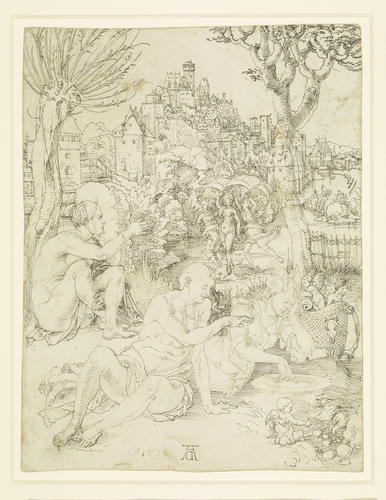Pupila Augusta c.1498
Pen and ink | 25.4 x 19.4 cm (sheet of paper) | RCIN 912175
-
A pen and ink drawing of three elderly women and three young women, in a mountainous landscape.
This enigmatic drawing by Dürer (1471-1528) has never been fully explained. It was clearly intended as a design for a print, as the lettering on what seems to be a basket to the right and the artist's monogram are both in reverse. The date 1516, not in reverse, has been added by another hand. The print, however, appears never to have been made. The design seems to draw a contrast between the three elderly women in the foreground and the three young women who approach them, riding on the back of a large fish, and who are indicated by the woman sitting to the left. Three small putti are to the right, two clambering on the basket, a third sitting with his hand towards a fleeing hare. One of the women, wearing a winged helmet, points to a bowl of water with her finger. She may be making a prophecy, the subject of which would appear to be the approaching group of young women.
It has been suggested that the background group depicts Venus or Aphrodite, who was born from the sea and came to land on the island of Cyprus. She is often shown, as here, appearing from the sea, a subject famously treated by Sandro Botticelli in his Birth of Venus, now in the Uffizi Gallery in Florence. A comparison has been drawn between the figures in the foreground and a scene described by Philostratus the Elder, in which putti also play, gather apples into a basket and chase a hare, 'as an offering most pleasing to Aphrodite'.
Dürer has assembled his composition from a number of Italian prints. The figure of the reclining woman in a winged helmet with putti and the basket with ox-head decoration is copied from a Ferrarese engraving. This print also supplies the inscription on the drawing, 'Pupila Augusta' ('august ward' or 'august orphan girl'), which has long been the subject of debate, but which Dürer has clearly copied from the print. The three young women riding a fish are taken from a small print by the Bolognese artist Peregrino da Cesena (active c.1490-1520). The hill town in the background appears to have been adapted from watercolour studies made by Dürer of the cityscapes of Trent and Innsbruck.
Although no print was apparently made after this drawing, Dürer must have retained it in his studio as he returned to the composition in 1506 for his painting of The Feast of the Rose Garlands, and in 1519 when he was designing his engraving of St Anthony, both of which feature the hilly landscape from the Pupila Augusta. It was probably at this time that Dürer used a browner ink to adjust the composition slightly, realigning a roof and filling in the sections obscured by the right-hand tree trunk, which does not appear in the print or the painting.
Initialled by the artist (in reverse) and inscribed 'PVPILA AVGVSTA'; inscribed '1516' in another hand
Catalogue entry adapted from The Northern Renaissance. Dürer to Holbein, London 2011Provenance
First recorded in a Royal Collection inventory of c.1800-1820 (Inv.A, p.15: 'an allegorical subject found amongst the Prints / Albert Durer')
-
Creator(s)
Acquirer(s)
-
Medium and techniques
Pen and ink
Measurements
25.4 x 19.4 cm (sheet of paper)
Other number(s)
RL 12175










